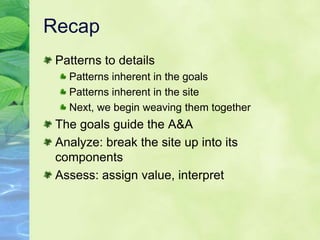A&a overview
- 1. Site Analysis & Assessment QuickTime™ and a TIFF (LZW) decompressor are neede d to see this picture.
- 2. Now that you’re done with your goals articulation, you should have… List of desired elements and species Problems, qualities, issues, likes Ideas for how to support and heal the land and surrounding ecosystems Design criteria to meet your values and goals A list of questions and topics to guide your analysis and assessment What do I need to know about the site to make these goals a reality?
- 3. Guidelines A&A connects the goals to the site It’s about patterns and relationships (remember: patterns to details) When we analyze, we break the site up into smaller, decipherable components so we can understand the relationships that exist between them The “What?”
- 4. When we assess, we assign value Assessment The “So What?” What are the implications for design?
- 5. Bubble diagrams Fat markers, big movements (patterns) Circles and arrows Reasonably messy Words and pictures Qu ic kTime ™ and a TIFF (Unco mpres sed ) d eco mpres sor are n eed ed to se e th is pi cture.
- 6. A&A is a summary of the current reality It’s ok to have design directions, but don’t get lost in them Note them and return to the here and now and the implications for design
- 7. Distinguish between observations (factual, neutral) --> interpretations (assigning value based on your background/perspective and your goals)
- 8. The Path Forward Start collecting info (maps, historical documents, soils info, climate data, legal info, info from neighbors and community)
- 9. Undirected observation and interpretation Now that you have your goals, go back and notice what you notice Connect back to your first impressions Can incorporate sector and flow analysis, or these can be part of your thematic observations
- 10. Thematic Observation Sector analysis Flow analysis Scale of Permanence
- 11. Scale of Permanence Climate Landform Water Legal Issues Access & Circulation Vegetation & Wildlife Microclimates Buildings & Infrastructure Zones of Use Soil Aesthetics
- 12. Overlay for each aspect of the s.o.p. (except climate) The goals determine the question you are asking and what you are looking for S.O.P. guiding questions Use words and pictures
- 13. Set time limits for each aspect Hold back on design, we’re buildin’ momentum here If you get stuck, return to the goals On each overlay: summarize the 3-5 most important points A&A Summary: summarize all the most important data from all aspects of the s.o.p. onto one overlay, using words and pictures
- 14. Landform Qu ic kTime ™ and a TIFF (Unco mpres sed ) d eco mpres sor are n eed ed to se e th i s pi cture.
- 15. Water Qu ic kTime ™ and a TIFF (Unco mpres sed ) d eco mpres sor are n eed ed to se e th is pi cture.
- 16. Access & circulation Q ic kTime ™ and a u TIFF (Unco mpres sed ) d eco mpres sor are n eed ed to se e th is pi cture.
- 17. Vegetation & wildlife Qu ic kTime ™ and a TIFF (Unco mpres se d) d eco mpres so r are n eed ed to se e thi s pi cture.
- 18. microclimate Qu ic kTime ™ a nd a TIFF (Unco mpres sed ) de co mpress or are n eed ed to se e th is p i cture.
- 19. Soils Qu ic kTime ™ and a TIFF (Unco mpres sed ) d eco mpres so r are n eed ed to se e th i s pi cture.
- 20. Zones of Use, Aesthetics Q ic kTime ™ a nd a u TIFF (Unco mpres sed ) de co mpres sor are n eed ed to se e th is p i cture.
- 21. A&A summary Q ic kTime ™ a nd a u TIFF (Unco mpres sed ) de co mpres sor are n eed ed to se e th is p i cture.
- 22. Recap Patterns to details Patterns inherent in the goals Patterns inherent in the site Next, we begin weaving them together The goals guide the A&A Analyze: break the site up into its components Assess: assign value, interpret
- 23. Undirected observation Sector and Flow Analyses Thematic observation guided by the scale of permanence Distinguish observations from interpretations
- 24. A&A Summary combination of the most important or influential observations and interpretations from all aspects of the s.o.p. summarizes the current reality on the site and its implications for design in relation to the goals lays foundation for decisions in design phase The more thorough the A&A, the smoother the design phase …The A&A discovers the design























